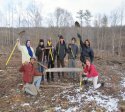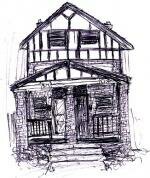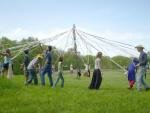Apeckalypse
By Janel Twin Oaks
In just a matter of weeks, Twin Oaks’ 150 laying hens have become frozen fodder for future community meals.
It all started late in the summer when new member Sapphyre and I decided to fill the much-needed poultry management position. We started doing research about proper chicken care--and the answers we found left us shocked. Suddenly, aspects of our fenced-in chicken yard that once seemed benign to my untrained eye began to pop out at me--the lack of top soil due to vegetation depletion, for instance, or the broken feathers on birds’ backs (indicating a possible feather mite infestation). Not to mention we realized that many of the hens were too old to efficiently produce eggs anymore.
Coincidentally, around that time I began devouring The Omnivore’s Dilemma at Valerie’s recommendation, and the picture that animal-pasturing expert Joel Salatin painted of a “happy chicken” began to haunt me. In the book, Salatin tells author Michael Pollan that fowls were meant to flit from area to area, scratching and pecking at the ground for bugs and tasty weeds. They were not meant to be confined, eating nothing but industrially-farmed corn and grains. Of course! Learning this was like unlocking a primordial instinct in me that had long been buried by civilization. After much deliberation and a few tears, Sapphyre and I decided the best thing to do would be to kill the birds and start over in the spring, hopefully purchasing eggs from local farmers until a Twin Oaks pastured poultry program is fully underway.
Luckily, we had former Oakers Jim and Shana to turn to. Jim and Shana dabbled in raising poultry for profit and built an impressive slaughtering station in their back yard--which happens to be two miles from the community. In exchange for LEX hours (labor IOU’s traded between communities) and a few chickens, Jim and Shana agreed to help us turn the entire flock into tomorrow’s main course, 50 birds at a time. Thus, every Monday in October became a meat processing field trip.
Halloween day marked our final slaughter with Jim and Shana. The air was warm and crisp as June, Valerie, Kele and I took off down the road, five pens of chickens in tow. Once at Jim and Shana’s, I stood next to the crowded cages of birds awaiting their fate and surveyed the scene: the upside down traffic cones in which the birds would “bleed out,” the de-feathering machine, the stainless-steel evisceration table. Trying to calm myself in the face of the lurking question, “Is this the right thing to do?,” I put my hand on a pen and whispered a thank you to the birds whose bodies would feed me throughout the winter. Then, I moved to my position at the evisceration table.
A couple hours later, 50 carcasses were cooling in vats of ice water, and Kele, Valerie, Shana and I were peeling the tough inner tissues from gizzards to prepare them for consumption. Our rambling conversation turned to the subject of birth and as I listened to the others swap stories of the human births they’d experienced, I was struck by the irony of discussing new life on a day of death. Yet the subject was comforting. It reminded me that spring will bring with it a rebirth of the Twin Oaks poultry program--and that I’m a part of that rebirth. I took a deep, healing breath, and I allowed myself to smile.
- Ethan's blog
- Login to post comments








